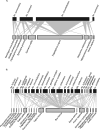Characterization of mosquito host-biting networks of potential Rift Valley fever virus vectors in north-eastern KwaZulu-Natal province, South Africa
- PMID: 39138532
- PMCID: PMC11323694
- DOI: 10.1186/s13071-024-06416-0
Characterization of mosquito host-biting networks of potential Rift Valley fever virus vectors in north-eastern KwaZulu-Natal province, South Africa
Abstract
Background: Rift Valley fever virus (RVFV) is a zoonotic mosquito-borne virus with serious implications for livestock health, human health, and the economy in Africa, and is suspected to be endemic in north-eastern KwaZulu-Natal (KZN), South Africa. The vectors of RVFV in this area are poorly known, although several species, such as Aedes (Neomelaniconion) mcintoshi, Aedes (Neomelaniconion) circumluteolus, Aedes (Aedimorphus) durbanensis, and Culex (Lasioconops) poicilipes may be involved. The aim of the study was to determine the vertebrate blood meal sources of potential RVFV mosquito vectors in north-eastern KZN and to characterize the host-biting network.
Methods: Blood-fed mosquitoes were collected monthly from November 2019 to February 2023 using a backpack aspirator, CO2-baited Centers for Disease Control and Prevention (CDC) miniature light traps and tent traps, in the vicinity of water bodies and livestock farming households. The mosquitoes were morphologically identified. DNA was extracted from individual mosquitoes and used as templates to amplify the vertebrate cytochrome c oxidase I (COI) and cytochrome b (cytb) genes using conventional polymerase chain reaction (PCR). Amplicons were sequenced and queried in GenBank and the Barcode of Life Data systems to identify the vertebrate blood meal sources and confirm mosquito identifications. All mosquitoes were screened for RVFV using real time reverse transcription (RT)-PCR.
Results: We identified the mammalian (88.8%) and avian (11.3%) blood meal sources from 409 blood-fed mosquitoes. Aedes circumluteolus (n = 128) made up the largest proportion of collected mosquitoes. Cattle (n = 195) and nyala (n = 61) were the most frequent domestic and wild hosts, respectively. Bipartite network analysis showed that the rural network consisted of more host-biting interactions than the reserve network. All mosquitoes tested negative for RVFV.
Conclusions: Several mosquito species, including Ae. circumluteolus, and vertebrate host species, including cattle and nyala, could play a central role in RVFV transmission. Future research in this region should focus on these species to better understand RVFV amplification.
Keywords: Arbovirus; Mosquito; Network analysis; Rift Valley fever virus; South Africa; Vertebrate blood meal sources.
© 2024. The Author(s).
Conflict of interest statement
The authors declare no competing interests.
Figures

Similar articles
-
Blood meal analysis and virus detection in blood-fed mosquitoes collected during the 2006-2007 Rift Valley fever outbreak in Kenya.Vector Borne Zoonotic Dis. 2014 Sep;14(9):656-64. doi: 10.1089/vbz.2013.1564. Vector Borne Zoonotic Dis. 2014. PMID: 25229704 Free PMC article.
-
Susceptibility and barriers to infection of Colorado mosquitoes with Rift Valley fever virus.PLoS Negl Trop Dis. 2021 Oct 25;15(10):e0009837. doi: 10.1371/journal.pntd.0009837. eCollection 2021 Oct. PLoS Negl Trop Dis. 2021. PMID: 34695125 Free PMC article.
-
Competence of mosquitoes native to the United Kingdom to support replication and transmission of Rift Valley fever virus.Parasit Vectors. 2018 May 18;11(1):308. doi: 10.1186/s13071-018-2884-7. Parasit Vectors. 2018. PMID: 29776384 Free PMC article.
-
Rift Valley Fever: An Emerging Mosquito-Borne Disease.Annu Rev Entomol. 2016;61:395-415. doi: 10.1146/annurev-ento-010715-023819. Annu Rev Entomol. 2016. PMID: 26982443 Review.
-
A review of mosquitoes associated with Rift Valley fever virus in Madagascar.Am J Trop Med Hyg. 2015 Apr;92(4):722-9. doi: 10.4269/ajtmh.14-0421. Epub 2015 Mar 2. Am J Trop Med Hyg. 2015. PMID: 25732680 Free PMC article. Review.
References
-
- Wanyoike F, Dizyee K, Bett B, Rich K. Application of system dynamics modelling in the analysis of economic impacts of Rift Valley fever: a case study of Ijara County, Kenya. Rift Valley Fever Vaccination Project Report. Nairobi, Kenya: ILRI. 2021.
-
- Machalaba C. Impacts of Rift Valley fever virus: a One Health approach to assess burden and inform prevention and control options. CUNY School of Public Health, Thesis. 2020.
-
- Jupp P. Mosquitoes as vectors of human disease in South Africa. SA Fam Prac. 2005;47:68–72.10.1080/20786204.2005.10873292 - DOI
MeSH terms
LinkOut - more resources
Full Text Sources

